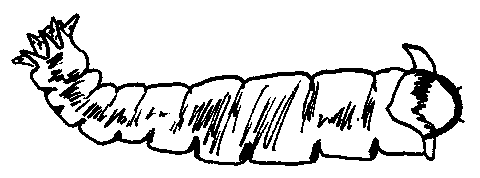
Tipula Paludosa Meigan
Kathryn Camille Fowler

Drawing of a tipula larva, dissected to show the otherwise hidden head capsule.
Drawing by Kathryn Camille Fowler, using How to Know the Aquatic Insects by
Dennis M. Lehmukuhl as a reference.
What is a tipula paludosa?
Tipula paludosa is one of the more common Crane Flies, and it is referred to as the Marsh Crane Fly or the European Crane Fly. Crane flies are the leggy flies often mistaken for mosquitos. Though they do not harm humans as mosquitos do, they resemble them anatomically, and Crane flies are in the same order, Diptera, as mosquitos. The Marsh Crane Fly possesses some of the anatomical qualities characteristic of the insects in the order Diptera. For instance, the gray-bodied specimen has halteres, which are reduced hind wings that sit right behind the two membraneous, somewhat silvery wings. Halteres are gyroscopic stabilizers which provide the necessary control needed in flying (O'Toole 1978). The head of t.paludosa is elongated, pointed and has two curved, short antennae (Klausnitzer 1987).
What are the larvae like?
The four-instar larvae of t.paludosa, referred to as a leather-jacket, lives in the damp soil and devours the roots of plants, many times causing a problem for farmers in areas of the United States such as Oregon and Washington. In Europe, t.paludosa larvae have caused a severe problem for farmers because they devour grain, the roots of grass, vegetables, and flowers (Stehr 1991). During the day, the larvae devour the roots, and at night, the larvae come above ground to eat parts of plants (Klautsnitzer 1993). A minimal amount of moisture in the soil is crucial to how well distributed the larvae are. Much of the development of larvae occurs during the first three instars, and the temperature of the environment as well as the food quality and food distribution play a large role. The larvae are legless maggots with muscles that enable the entire head to be withdrawn into the thorax for protection (Williams 1992).
The sex-ratio of t.paludosa is curious; according to Jean Goedart, the distinguished painter and observer of nature, there are about ten times as many males among them as females. Goedart also reported that the female layed her eggs by depositing them in the ground (with her ovipositor). Reportedly, the eggs take about three years to hatch.
Who is the taxonomic authority?
Meigan was the authority who first classified this species. Though no information on his literary work is available, other scientific greats gave attention to t. paludosa, including Antony van Leeuwenhoek. In Klaustnizer's work, Insects, Klaustnizer quotes Leeuwenhoek. Leeuwenhoek described the larvael stage of t.paludosa, which is called a leather-jacket if it lives in the soil. Leeuwenhoek described how he captured t. paludosa larvae and emphasized the importance of watering them. Leeuwenhoek also noted the high male to female ratio (Klausnitzer 1987).
O'Toole, Christopher. Ed. 1989. The Encyclopedia of Insects. Facts on File, Inc. New York.
80 - 81.
Tipula paludosa |
|||
|
AREA |
STATUS |
REFERENCES |
|
|
Europe |
Yes |
Bland, 1978 |
|
|
United Kingdom |
Yes |
Alexander, 1919 |
|
|
Yes |
Alexander, 1919 |
|
|
Yes |
Bland, 1978 |
|
|
North America:
|
Yes |
Bland, 1978 |
|
|
Eastern North America: United States East of Mississippi; Ontario and eastern Canada
|
Probably Not |
Kathryn Fowler |
|
|
Southeastern United States: |
Probably Not |
Kathryn Fowler |
|
|
Southern Appalachian States: AL AR DE DC FL GA KY MD NC SC TN VA WV |
Probably Not |
Kathryn Fowler |
|
|
Coastal Plain |
? |
||
|
Piedmont |
? |
||
|
Blue Ridge Mountains |
? |
||
|
? |
||
|
Ridge and Valley |
? |
||
|
Cumberland Plateau |
|||
|
Central Arch |
Probably Not |
Kathryn Fowler |
|
|
Georgia |
Probably Not |
Kathryn Fowler |
|
|
Clarke County, Georgia |
Probably Not |
Kathryn Fowler |
|
|
Sam's Farm |
|||
|
|
Probably Not |
Kathryn Fowler |
|
|
Probably Not |
Kathryn Fowler |
|
|
Probably Not |
Kathryn Fowler |
|
|
1-Hectare Plot |
|||